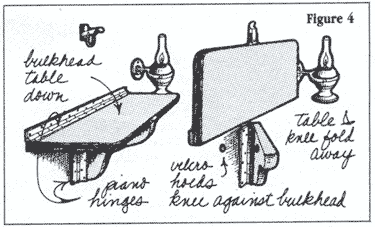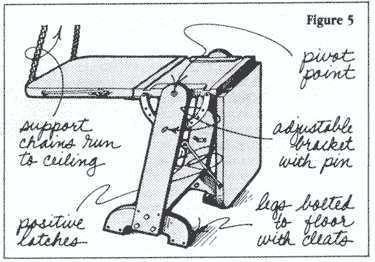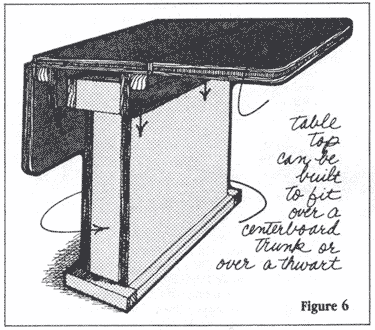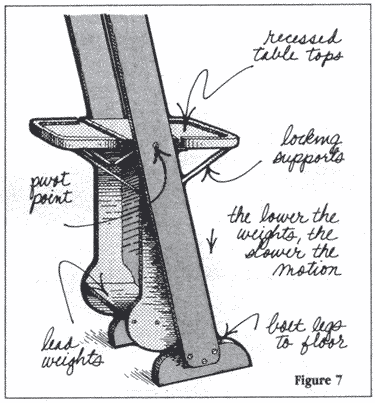|
A well-designed table is a perpetually useful piece of furniture
in a boat. And even the smallest boats can usually afford
room for some type of table, even if it's only temporary and must
be folded away when not in use. After all, few people like to eat
with a deep bowl in one hand while clutching a cup between
their knees!
Small boat owners should learn to think in terms of not only
drop-leaf but also raise-leaf, collapse-leaf, removable- and even
disappearing-leaf tables. Once thinking this way, you'll find
techniques to provide handy table space for workshop and
galley in tiny forepeaks, under tent shelters pitched from gunwale to gunwale, and in knee bumping cockpits.
If you have no room at all but need a surface on which to
assemble a sandwich or salad, a small tray with a neck strap
provides a simple solution. By sitting upright, you can balance
against the motion of the boat and keep a relatively level surface.
It takes some experimenting (and spilling) to get just the right
combination of strap length and body motion. If it's really rough,
try attaching the tray around your waist with shock cord.

We built a small removable table (Fig. 1) for an 8-foot Norwegian pram, stowed it under the thwart, and used it for years. It
worked great for picnics afloat. It had a couple of bent brass
hooks on one side that fitted into the gunwale spaces, and we
used two pine wedges to lock it in place. An adjustable leg on a
hinge provided support regardless of the table's location.

If appropriately located, a keel-stepped mast offers another
spot to attach a table (Fig. 2). The table can be designed to slide
up and down the mast and may be stored by attaching it to the overhead. Make stops on the mast for supporting the table, and if
the table is large, also add overhead support chains.

Tables mounted on bulkheads come in all sorts of styles, from
complex accordian-leaf structures to simple removable single - or double-leaf types. The simplest is supported by a cleat
attached to the bulkhead, with holes for dowels or pins onto
which the table is fitted and fastened (Fig. 3). A leg or support
chain is usually necessary. When the table is removed, there's
nothing left but the cleats.

Hinges & Pivots
Another bulkhead-mounted type uses a hinge and folds
flush, up or down, when not in use (Fig. 4). For support, a
hinged knee also folds flat against the bulkhead, held in place
by a spot of Velcro. Piano hinges give support and are an ideal
hinge for the wide span of a table leaf. They also provide
alignment and strength for accordian-leaf tables.

For those long runs in the trades, when the boat is on the
same tack for days and nights on end, an adJustable table may
be a big help in coping with an inclined world below decks (Fig.
5). By providing some type of locking mechanism — a thumbscrew or adjustable bracket — the table may be permanently
held in one position a little closer to horizontal. Also remember
that the folded leaf of a table must be held tightly in place or will
bang constantly, even at anchor. Shock cord works well.

Centerboard trunks, situated as they usually are on the centerline of the boat, also provide a good support fora drop-leaf
table (Fig. 6). The table can be built so it's removable. Tables
traditionally run fore and aft, but in small boats they may be
mounted athwartships. Use whatever works best.

lf you have the space for it, a counterweighted drop leaf that
maintains a semblance of levelness athwartships may be the
ultimate in seagoing tables (Fig. 7). As with all large tables, the
legs must be securely bolted to some point of attachment,
whether sole, bulkhead, or overhead. Experiment to get the
weight and arm length just right. Too much weight below the
pivot point will make the table too sluggish; too little weight
and the table's motion will be too snappy. Length of the arm
from pivot to weight is also critical. What's right for one boat
may not work for another. You should provide a positive stop to
quiet a counterweighted table when not in use and attach the table securely lest it comes adrift and walks all around the cabin
in rough weather.
|
Table Top Tips
Any table or tray maybe made more efficient bycutting holes for
tapered glasses or mugs. You can also try a thin sheet of neoprene or
a similar soft and sticky material to hold plates in place, or you can
even recess areas in the tray bycutting away the wood with a router
bit.
Most traditional boat tables and counters have fiddles (rails) on
the edges to hold sliding plates and silverware. Fiddles are commonly attached on the sides of the table only, and the corners are
left open to aid in cleaning.
— Paul Butler |
Even if your boat has marginal space, with these tips you can
still figure out ways to build a very unobstrusive yet functional
table, making dinner time aboard ship feel like home!
|

